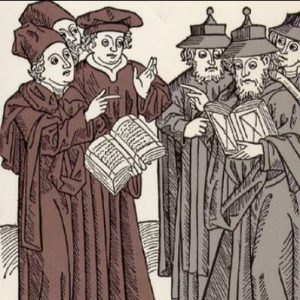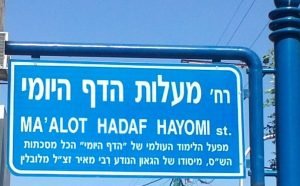You are learning the daf with a friend. She reads a passage but it does not appear in your Gemara – what happened to it? If the Gemara is Sanhedrin and you are learning from an older edition of the text, the passage has been censored out. Here is part of the offending text:
“But isn’t it taught: On Passover Eve they hung Jesus the Nazarene. And a crier went out before him for forty days,: Jesus the Nazarene is going out to be stoned because he practiced sorcery, incited people to idol worship, and led the Jewish people astray. Anyone who knows of a reason to acquit him should come forward and teach it on his behalf. And the court did not find a reason to acquit him, and so they stoned him and hung his corpse on Passover eve.” (Sanhedrin 43a)
The continuation of the text lists five students of Jesus: Mattai, Nakai, Netzer, Buni, and Toda. They also were tried and sentenced to be executed, despite their attempts to be declared innocent. All this is missing from most editions of the Gemara.
Who censored the Gemara and why? The story goes back to Christian attempts to convert Jews. From the beginnings of Christianity as a religion, there has been a desire to convert the Jews to a belief in Jesus. For the first thousand years or so, the philosophical approach (as opposed to physical coercion) was to attempt to prove to Jews that their understanding of the Bible was wrong. If only the Jews could see that the Bible itself foretold the advent of Jesus and of Christianity, they would instantly convert. Jews, alas, failed to follow this logic and converts were few and far between.
It was only in the twelfth century that Church Fathers began to be aware that Jews relied on another book to interpret the Bible – the Talmud. This became the new battleground and the friars of the Dominican Order were some of the most ferocious soldiers. They could not navigate the sea of the Talmud alone but relied on Jewish converts to Christianity to explain to them where the Talmud disparaged Christianity and/or proved its truth.
In 1236 the Dominican friar (and former Jew) Nicholas Donin presented Pope Gregory with a list of thirty-five “charges” against the Talmud, including that Jews believed it was divine and that Christians could be put to death for studying it. By 1239 the Pope was so convinced of the evil of the Talmudic text that he issued an order to have all copies of the Talmud in France, England, Portugal and Spain confiscated and destroyed. Only France took this order seriously but instead of seizing the Talmud, King Louis IX ordered Donin to hold a public disputation on the Talmud with his former teacher, Rabbi Yehiel of Paris.

Johann von Armssheim (1483), Public Domain, Wikimedia Commons
Despite Rabbi Yehiel’s valiant efforts, which included the claim that when the Talmud disparages non-Jews and their beliefs, it is only referring to idolators, he lost the debate. Louis ordered all copies of the Talmud to be seized and brought to Paris. Twenty-four wagonloads, including thousands of manuscripts, were brought to Paris and publicly burned in 1242.

Place de Greve in Paris where the Talmud was burned
Severnyiphoto: Polbuilding: ?, Public domain, via Wikimedia Commons
The tragedy of this fire is indescribable. It took place in the thirteenth century, long before the invention of the printing press. Each of these manuscripts took months, if not years, to write, cost large amounts of money, and in many cases were the only text available in a certain area. The loss to Jewish scholarship was enormous. Rabbi Meir of Rothenberg composed a lament for this occasion which some communities still recite on Tisha bAv, שאלי שרופה באש.
After this shocking event, French rabbis approached the Pope and told him that the Jews needed the Talmud in order to practice their religion. The Pope agreed to stop destroying the Talmud (although the burnings still continued sporadically) but insisted that the books must be censored to take out any offending material. This censorship became especially prevalent after the printing press was invented and large numbers of books could reach the public. Sometimes the Jews censored the books themselves and sometimes Church censors were dispatched to take care of the problematic texts. In this way, any mention of Jesus and Christianity was expunged and often these censored texts were forgotten.
In the nineteenth century, a Jew named Raphael Natan Rabinovicz discovered a one-volume manuscript of the Talmud written in the fourteenth century by someone named Shlomo ben Shimshon. It was located in the government library in Munich and came to be known as the Munich manuscript. It included passages that were missing in other Talmud manuscripts. Rabinovicz dedicated more than twenty years of his life to comparing texts and publishing volumes called Dikdukei Sofrim that included all the censored passages. Today modern scholarship has filled in even more of the gaps.
And yet, most texts of the Gemara still do NOT include the censored passages. Why? Jews like tradition and want to keep the text the same as it has been for centuries, despite the fact that the ones who helped create that imperfect text were our enemies.
And what does our censored text tell us? It seems to be speaking of Jesus’ execution, although Rabbi Yehiel claimed that the Jesus in the Talmudic stories is not Jesus the Nazarene. Certain telltale details stand out: his execution on the eve of Passover fits with the Gospel of John’s date (John 19:14). He is hanged after he is stoned, recalling crucifixion (although there the person was hung while still alive). The names of his disciples include two who really were Jesus’ disciples according to the Gospels: Matai (Matthew) and Toda (Thaddeus). It seems to be a text that parodies and disparages the story of the historical Jesus.
Christian censors were sure that the Talmud was full of anti-Christian slurs. In reality, there are very few stories about Jesus and Christians. This is one of the more historical ones; we also have references to a bad disciple of Joshua ben Perahyah named Jesus (Sanhedrin 107b) and some slurs about Jesus’ parents (Shabbat 104 and other places). The rabbis were not too interested in Jesus and Christianity. For the Babylonian amoraim, Christianity was not their main problem, Zoroastrianism was. And even in the Land of Israel, Christianity was not enough of a threat (spiritually) to Jews that it needed discounting.
Talmudic texts have been threatened, censored and even burned. But the Jewish love for them is stronger than ever – witness the daf yomi revolution.

דוד שי, CC BY-SA 3.0 <https://creativecommons.org/licenses/by-sa/3.0>, via Wikimedia Commons










